Simon Jones
Imag[in]ing the Void: Or Hiding in Plain View:
Thoughts after Bodies in Flight & Angel Tech's WHO BY FIRE
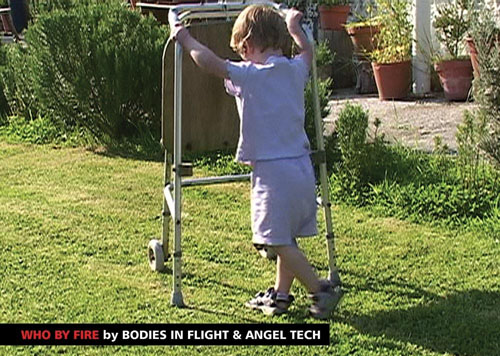
Let’s begin with a preamble of some remains from previous work, that is, the informing of a method, what we – the collaborators of BODIES IN FLIGHT (Polly Frame – associate artist & performer, Sara Giddens – co-director & choreographer, Simon Jones – co-director & writer, Graeme Rose – associate artist & performer) – call a principling.
This writing moves towards a principling of WHO BY FIRE (2004-05), the thirteenth performance-event of BODIES IN FLIGHT.
From the very beginning, there has always been a radical erotics: the point where flesh encounters text, when flesh utters and words move. Both from the very beginnings of the gathering of performance (pre-historic) and the very intimacies of our own engagement with performance (1989): a going far back and a going far into. The audience member, no longer merely an observer, once more becomes a participant. The fundamental point in this relationship is the doubled face-to-face: firstly of the performer—audience-participant, secondly of performer—performer. Here the key image for us is the annunciation, when the word was made flesh, and the divine and the human looked into each other’s faces.
And thence technically, BODIES IN FLIGHT’s work became an investigation of the nature of this encounter, leading us to what enables these face-to-faces to happen – the in-between, the media, the middle. Here I’m reminded of Foucault’s writing on Magritte: the aporia between “speaking and representing” can be transposed to sight and sound, hearing and vision. The audience member, no longer wholly themselves, can be bifurcated thus into the auditor-spectator participant.
By ruse or impotence, small matter – the calligram [picture-poem] never speaks and represents at the same moment. The very thing that is both seen and read is hushed in the vision, hidden in the reading. (Foucault 1983: 24/5)
This bifurcation itself reveals a general problem with the definition of the bodies involved in performance: their boundaries and constitution, their mixing and opennesses. So, the performance-event becomes a privileged site for modelling the possibilities of bodies mixing: performer—auditor-spectator-participant. It is a middle that meddles. For us, this key encounter and mixing of bodies can be thought of as the cleft cleaving, both unto and asunder, the edge of touching at the limit of the known body and before the unknown other.
The body is the inscribed surface of events (traced by language and dissolved by ideas), the locus of a dissociated self (adopting the illusion of a substantial unity), and a volume in disintegration. (Foucault 1977: 148)
Furthermore, one of the crucial in-betweens is that between our-selves as makers of performance. We began to formulate collaboration as a dialogue as defined by physicist David Bohm: a radical openness of listening and watching and responding and suspending judgement, within which each discursive practice is separately investigated (choreographic, musical, sonic, textual, visual). This collaboration is a making or wrighting alongside, what we call a dwelling alongside, which is nothing more than a radical and sustained attending to the material at hand in all its here-now-ness.
The basic idea of this dialogue is to be able to talk while suspending your opinions, holding them in front of you, while neither suppressing them nor insisting upon them. Not trying to convince, but simply to understand. … That will create a new frame of mind in which there is a common consciousness. It is a kind of implicate order, where each one enfolds the whole consciousness. With the common consciousness we then have something new – a new kind of intelligence. (Bohm: 118)
And thence we considered the final in-between with the others – the auditor-spectators – who participate in the performance-events them-selves: they travel in their own way from their everydays to experience our work and then return home but never quite by the same way. This obliged us to use as our base material the everyday, so that our work would always have a direct and embodied relation to those other-part-outsiders. We combined these various concerns – the dissolving of the body’s integrity, the opening up of the senses’ aporia, with our face-to-face with our auditor-spectators. Our primary principling became a de-second-naturing – in effect a deconstruction of our commonsense of the everyday, so that everything we thought we knew so intimately we did not even have to think about it, we simply did and felt it, is de-naturalized and once more made strange to us, even the very way we each walk or talk. This de-naturing occurs on a micro-level of choreographic attention. This attending to the (every) body’s separate discursive practices dissolves their illusion of unity and continuity upon which what we know is founded. These practices then become strange to both performer and observer, they become visible, they appear, and can thence be manipulated as aesthetic material, reconstructed to produce a work that itself appears to work alongside the everyday from which it is made and to which it is addressed by way of its auditor-spectator-participants.
A key instance is the sensitivity to initial conditions that marks the point at which any system is most ready for its environment, most ready to be open. A properly attuned audience feels such a sensitivity: they are capable of leaving behind their everydays and entering into the world of the work. It also drives the attention of the collaborators to each others’ practices, permitting an exchange of energy, ideas and material that mutually informs each artist, inflecting their journey through the work and contributing to the developing gradients of force within it.
(And henceforward what I write I would not have written, had I not been part of the making of WHO BY FIRE. The following reflections and thoughts emerge from the very intensities experienced in the rehearsal spaces, in discussions with collaborators at breakfast, at dinner, in the performances and in the many talks with audience members, friends and others alike – I thank them all!)
So, the opening on to a work is critical: how an auditor-spectator is inducted into the work, literally led into it (in the case of the previous show SKINWORKS (2002-04) by the hand into the performance space). Since we want the work’s out-of-the-everydayness to be lived in comfortably, we have a duty of care to this sensitivity to the beginning, not to terrorize or traumatize it with obvious (literally – “in-the-way-of”) strangeness. This is likely to produce the reaction of drawing up barriers, either physical or intellectual, between the individual and the performers, refusing eye-contact or adopting a theoretical distanciation. In order to meet this duty of care, we choose to begin in a place / topos which people would immediately recognize, that is, have an im-mediate (“without middle”) association with: for instance, in SKINWORKS, the self-descriptions posted in chatrooms.
For WHO BY FIRE, we chose the following scene: the end of a party, at the dead of night or turn of day, a group of friends, exhausted from partying, sitting around the kitchen table, sharing stories of strange events – in this instance, encounters with death, some humorous, some morbid, some touching (incidentally all of them except one personally true). This improvised conversation lasted about half an hour. Because of the performers’ position-ing around the table on stage, their speech was sometimes barely audible: they seemed to be making no effort to “project” their voices. Occasionally one might get up and go off stage for a time. For no apparent reason, there were two gaps in the conversation when the performers appeared to freeze: however, the pose was broken before it could be recognized as properly happening, before it could be read. In this way, the auditor-spectators were led into WHO BY FIRE, into its concernful space-time of in-betweens, by an immediate association with the everydayness of its “situation” and thence the gaps seemingly “naturally” opened up.
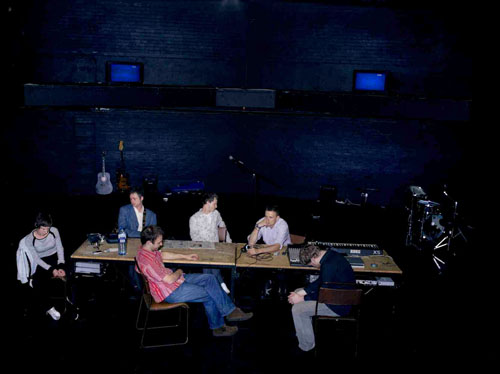
The material beginnings, as with all BODIES IN FLIGHT’s work were the leftovers from the previous show, in this case – SKINWORKS, which had explored through the topos of cyber-sex how technology can both accelerate and stymie human desire with its inhuman super-fluidity, how identity can dissolve and open itself out to possibility without bodies, but in doing so exhaust itself within virtuality. SKINWORK’s closing mood was the feeling of having surfed, of desire having disappeared into this void. So, WHO BY FIRE’s opening question was – could this void be imagined? Or rather, could the dilation of self and desire, encouraged by this void, be realized as a radical form of intensity?
As the improvisations sometimes lasted over an hour, we had video-cameras recording the material for later reference. We noticed the way the camera’s auto-focus function behaved stochastically as lighting conditions and performers’ positions altered through the day, sometimes focusing on performers, othertimes on the wall or a piece of furniture. This point of the pull-focus became a profound concern in the initial workshops, this instant of intelligibility, an impossible-to-predict, impossible-to-repeat point of coming upon, of realizing knowing from out of not-knowing – an ex-cept-ing, as op-posed to ignorance itself. Furthermore, the auto-focus, the point when the camera renders something real from the background fuzziness, marked the machinic, extra-human creation of reality, a technological moment that mimics or repeats the human instant our consciousnesses leap over in their rush to grasp a working snapshot of the scene before us. The undecidability of this point, under certain conditions, draws our attention to the constructedness of all reality: what camera-operators call “breathing” realizes the very production of any and every reality. And this constructedness, which we have de-natured in different ways in past work (see our archival CD-ROM FLESH & TEXT), also draws attention to mastery itself, since our ability to realize anything from the void of absolute sensory information depends entirely upon our competence within the chosen discursive or embodied practice.
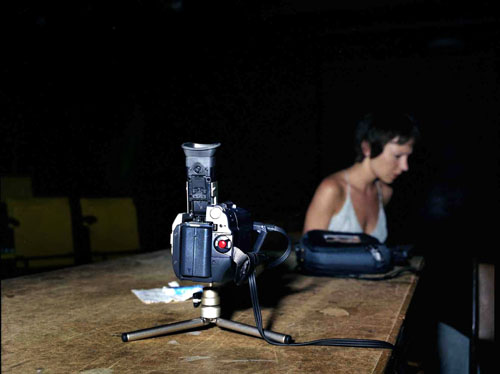
The various media-technologies, used in the work, both sonic and video, effectively externalize this in-between-ness – knowing—not-knowing. So, a play between raw and treated material ran through the work: for instance, in each sequence the music was made with a different mix of technology, sometimes pre-recorded and synthesized sounds combined with live voices, sometimes acoustic instruments played live with un-amplified voices, sometimes live voices singing along with pre-recorded instruments. Throughout the work, the sound generally moved from comparatively less to comparatively more technical mediation, the music-making itself gradually receding from the present to another time and place – from the stage to the recording studio.
Furthermore, we articulated a series of relations, a kind of conceptual topography, as we went along, within which to place our critical reflections on the material generated in the workshops:
TEXTURE-----TEXT | ABSTRACT-----REAL | PRE-IMAGE-----IMAGE-----AFTER-IMAGE | MOOD-----SONG-----EXHAUSTION | TEXTURE-----TEXT-----DOCUMENT | FLAT IMAGE-----EMBODIED IMAGE | FRONT-----BACK | UP-----DOWN | IMAGE-----BACKGROUND | FOCUS-----FUZZY | TEXT-----CONTEXT | IMAGE / IDEA-----EVENT / BODY | WORD-----FLESH
on music, mastery & technology
Formally we had thought of SKINWORKS as a melodrama – spoken text with an accompaniment of sound. We wanted to continue our collaboration with the band ANGEL TECH and our exploration of the possibilities of music-theatre: so WHO BY FIRE was conceived as an opera, structured by its sound. As a medium, music allows for slippages between texture and text in the space-time event of performance: its abstracted organization of sound is able to move ineffably between the concrete and the conceptual, as well as working away directly on distinct aspects of cognitive awareness, themselves incorporating and interpolating the conscious and the subconscious, the felt and the thought, the embodied and the intellectual.
Whereas verbal and visual images may be understood as puncta or points of attention and recognition which work as conductors of energy and interchanges of ideas, apparently materializing the mood of the event, music works rather differently to sustain that mood over space and time, rather than focus or suspend its flow. Unlike the image, the sensation of materializing the mood by way of music cannot be pointed to in any particular place at any specific time: its force materializes the mood through the entire space-time of the event by way of a counter-force of materializing non-specificity and non-temporality. This is itself a dimension of connectivity of ideas and material similar to the action of a superconductor in physics, or Bohm’s notion of the relation between implicate and explicate orders. It became for us, therefore, the ur-background of the work, the intermezzo or base medium, the first in-between of this work, forming a mood, into which each song could then be placed / positioned, each with its own specific generic framing. In WHO BY FIRE each song went on to draw from a different genre – hymn, punk (drinking song), lament (acapella quintet), love-duet, operatic aria, rap, lullaby. This echoed the same relation of mood to point as the induction conversation, then-there each anecdote worked as a holographic perspective emerging out of the sense of shared time, its clarity intensified by the feeling it was being told from personal experience.
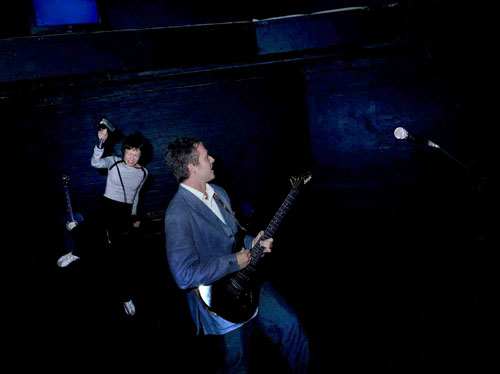
We happened upon a dialogue of twins’ pre-verbal “talking” between themselves which we used as the base material for a central concern of the sound: it became a record of the feeling when-where an image should appear – of two persons becoming in their jointly coming upon language. From the outside of this private talk captured by their parents, collaborators on the project, it sounds like a babble drawn down from the unintelligible whoosh of sound the twins hear of our talking. The recording realizes a kind of aspect of this sudden and unrepeatable and totally forgotten point of coming upon the Word: a kind of pre-image since that impossible point is approached indirectly – a no-where now-here between their talking without words and our second-natured listening amongst words. And the Word was made flesh because Gabriel said so. And then never again any going back on this expression of the divine, this miracle of language that founds our selfhoods with the breath inhaled, and exhaling trashes them upon the endless sup-positions of others’ possibles. These words that cause our minds to come into the world, that in two successive instants both realize the possibilities of that world and then render them insufficient. These minds that bring the superhuman into the world. O, hushed interlude. Listen to this babble – the private dialogue of the just-about-to-be selved, of the point of becoming self. O, listen to the miracle, expressed through every single person’s now-long-forgotten first articulated breath that meant something. Can you put your finger on the point they become real?
[FOLLOW [link] scroll down, then click on EARLY SOUNDS]
Angel Tech sampled the flow of non-words to produce a series of sound-bites. These were then re-ordered to produce a base-line melody, to which a lyric (which had been written independently) was set. In this Lament sequence, each sound-bite was individually “taught” to a performer and then combined into the full lyric. The com-position was made somehow between the twins’ private dialogue, audio-sampling software, the trained ear listening to each bite for its combinatory possibilities, and the improvisation exercise that combined musician, computer and performers with lyric and space.
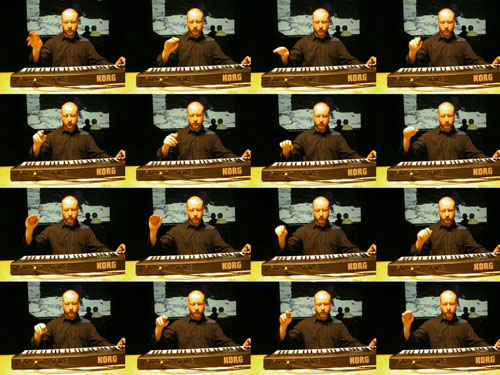
[FOLLOW [link] scroll down, then click on LAMENT]
Just because
Thoughts can go backward
Does not mean
You can have your life
Over and over again.
Just because
The mind burns deep
With one particularly sweet and sour image
Does not mean
You can have him
Over and over again
Or make her go away
For all time.
Just because
Is no good logic
The world does not work
To the pattern of your thoughts
And your flesh will never submit
To the possibilities of your mind
However closely they appear to cling
To each other’s insufficiencies.
From this concern with competence and the particular instance of the pre-verbal twins, it became clear that mastery is always temporal, or rather, always part of a chronology. We are born into language; we must practise a musical instrument or a dance-move. We realized that the timeline for coming upon knowing, the instant of intelligibility, in some ways resonates with the instant of recognizing an image: that is, the pre-image when-where one senses that an image should appear, the image itself which one reads, and then the after-image, the feeling of when-where an image has been. Mastery of the voice was our ground: the child who apes speech with sounds that are not yet words, the singer whose voice is trained to sing, and the elderly performer whose once practised voice can no longer hold a tune. This timeline of coming to knowledge, to competence, and leaving it behind, provoked other timelines: the human life-cycle, itself related to the cycle of seasons; the situation of the work was positioned at the in-between point of the daily cycle – just before dawn, and concerning itself narratively with the end of life, the end, of course, implying a new beginning.
And the coming upon was also played upon in one other sense. Re-presenting the teaching of the lament points to various kinds of displacement of competency we explored throughout the work: the infant whose understanding of how and why she is being videoed can only be very limited; the performers whose voices are not trained to sing; the musicians who are not trained to dance; the elderly performer who is all too aware that she can no longer sing as she used. These displacements of skill, the courage of presenting oneself professionally by way of a discipline one has not mastered, the innocence and vulnerability such a move discloses, all emerge from the baseline of the opening conversation in which the everyday (specifically non-theatrical) speaking voice is the practical means for all performers, an equitable, shared competence. Thence the speaking progressively yields to singing, the naturalistic posture and action to choreographed pose and move, the second-natured to the de-second-natured, challenging each performer in some specific way, depending on their own history of performing.
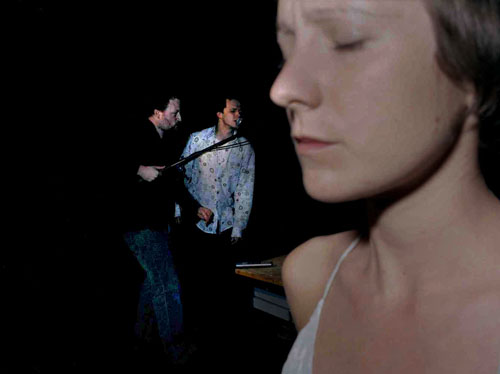
Furthermore, the audio-visual technologies externalize and de-humanize mastery since they work at accuracies and speeds beyond our selves. So the various cybernetic combinations position the performer in a precarious relation, having to prove their own competence in response to the machinic. As the work moves from a mix of elements dominated by the “live” production of image towards a mix that comes to depend increasingly on the “pre-recorded” and digitally mediated, it becomes more about memory, the archetypal images triggering deeply personal recollections and reflections in the auditor-spectators (as many subsequently reported). For instance, Sheila Gilbert the elderly performer appears only by way of video and is heard only by way of audio, and never both media at the same time: she re-presents (amongst other things) an archetype – the mother – at a distance technologically. This technological in-between opens up another irresolvable, though felt gulf between the present performance-event, which can be pointed to, and the previous events of recording, inscription and composition, which are also there feelingly. At the end, the performers are all moving together for the first and only time, using a shared choreographic vocabulary (itself derived from the infant’s hapless steps captured on video), gradually leaving the stage, until only one is left staring at a tiny screen showing footage of the woman-performer shot earlier in the performance: the shared, lived (immediate) past of both auditor-spectators and performers now itself an externalized, technological memory.
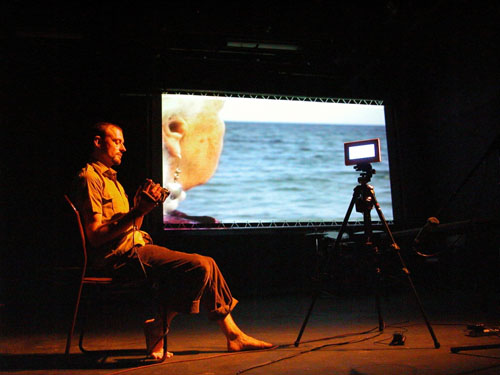
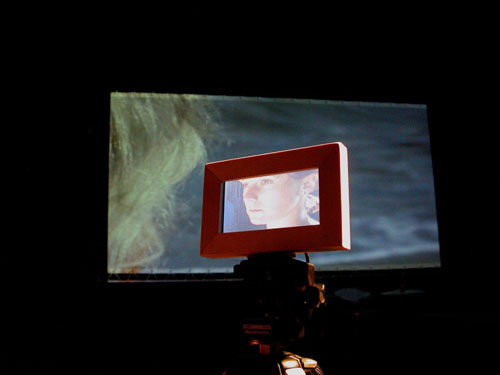
[FOLLOW [link] scroll down, then click on SHEILA’S SONG]
Visually we used found images for the first time since 1989 (DEADPLAY), for two related reasons. Firstly, after having ventured into the void and exhausted ourselves at the end of SKINWORKS, the return to the everyday is enabled by the found, what has already been worked out, already been imagined. Secondly, that void is not empty, it is saturated with what has already been felt and thought, from the deepest pasts and the furthest reaches of genealogy. So, we set about making a new work from some of the most influential images inherited from our culture – the annunciation, the deposition from the cross, the pieta, and various other sacred images. We chose these for the intensity of cultural investment and interconnectivity in their making and subsequent reception and use. The timeline of coming upon knowing (discussed above) led us from specific archetypal images (space-image) to consider archetypal forms (time-image), such as the four elements (air, earth, fire, water) and four seasons, human generation (the infant, the adult, the old), such as song-forms (the lament, the lullaby, the aria, the duet). These considerations helped to decide what material to video and how to structure the music in the work.
However, the shoots themselves were not planned in any detail: having to respond both to weather conditions and a young child as subject
Having decided what to shoot, the spatial-temporal experiencing of the image in rehearsals conditioned how we used the video material in the performance. Although the intention with each shoot was to focus upon the image’s archetypical content (for instance, the isolated infant in a snow-covered field or playing in a blooming garden, or an old woman looking out over the sea), the material we selected for performance was predominantly the “wild footage” when the camera is haplessly searching for its object, chasing the infant around the garden or zooming to frame the old woman “properly”, that is, skilfully and conventionally. The texturality of these in-betweens, these out-of-focuses, interested us as materializations of what technology alone can grab: our minds will refuse to see the eye focusing unless tricked into it. We used very slow-motion edits of this material to draw attention to this texturality. Furthermore, to draw attention to our attending to this materializing, we set this alongside “raw” footage of the camera panning and tracking, framing and zooming wildly. We showed this material in different scales, by different means, and across the full depth and width of the given performance space: front projection, back projection, LCD screen, four by two meters, one by one metre, ten by twenty centimetres. The first sequence began by delaying the point of focus, minimizing the image proper. Then through each successive sequence, the image was approached indirectly by different combinations of the above, until the final sequence ended with a thorough dwelling in the image’s archetypicality – the three females (infant, young woman, old woman) on the beach (variously playing, walking into the waves, looking at the horizon).
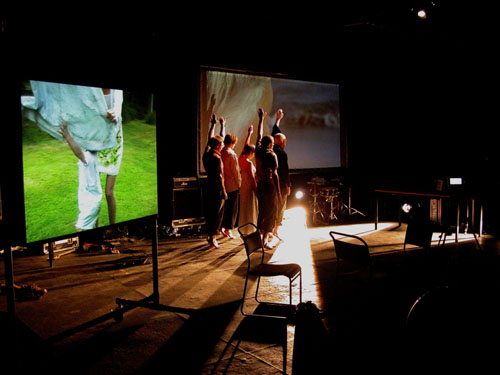
This attending to the forming and recognizing of an image, the apprehending of its materializing, makes evident a particular relation of image to event of special relevance to performance as an art-practice. Let us suppose, along with A. N. Whitehead, that every thing is an event of the working out of matter through time, its ex-pressing, or what Bohm would call – its explicating. So what appears solid (Whitehead uses the example of iron) is only a quality of solidity relative (say) to ourselves who appear less solid: marble (say) is not a thing as such, but an event of marbling. Hence, we can say of every event that it is, both in its effect and in its essence, merely the appearance of its quality – an image. These qualitative disclosures are always both in fact and relative to their particular facticity: they must happen, literally take place, in a certain space and time: they must be positioned. So, we ought to use the gerund wherever possible, itself grammatically “express-ing” the relation of noun to verb, action to thing, to re-mind ourselves of this fundamental relativity amongst what appears to us here now.
Consider a molecule of iron. It is composed of a central core of positive electricity surrounded by annular clusters of electrons, composed of negative electricity and rotating around the core. No single characteristic property of iron as such can be manifested at an instant. … But iron is not an expectation [i.e. of the theory of iron’s existence] or even a recollection. It is a fact; and this fact, which is iron, is what happens during a period of time. … There is no such thing as iron at an instant; to be iron is a character of an event. (Whitehead: 22/3)
Furthermore, we could extend this thought beyond the natural sciences, as Michel Serres has done, and say that persons are images; and in realizing this, we come upon what he sees as the image of humanity, what materializes our essence – that we are nothing but an image apprehending itself as image. This, he argues, brings us close to the apparitioning of angels, the annunciation itself.
[Fra Angelico’s Annunciation] takes place as if God was face to face with God. … Our physical eyes of flesh see Mary and Gabriel, but faith contemplates, in spirit, the apparition facing the incarnation. (Serres 1995a: 111)
So, if we are to explore what constitutes an image, we find very quickly that we have to go beyond the everyday definition we use in our so-called media-saturated culture, the assumption that all the visual representations that surround us daily are indeed images. When we come to performance with its kinetic-plastic embodied agents and its spatial-temporal, contingent-local axes, the ready definition of the still and legible, manipulable and copyrightable image blurs, reflecting uneasily on our fuzzy use of the term in the everyday. Maybe what we commonly think of as images are not images at all, but in their concatenation aspects of the background texture of the everyday – its texturality. Maybe we should rescue the word image from such overuse and reserve it for more extraordinary occasions, glimpses of the beyond, windows of appearances of the divine. Maybe an image is the point of realization poised / positioned between the background fuzziness of everyday texturality and a (as in singular and one and only) foregrounded clarity of an extraordinary idea-text. And here we need to be clear about what we mean by point: I think of it as an abstract object, as in mathematics, manipulable in terms of the various equations, a conceptual device to bring together various apparently unconnected and perhaps contradictory descriptions or explanations. This abstraction is never in fact realizable in life, for the simple reason that there can never be enough space and time to gather together into a demonstration all that informs the appearance of any instant: we can point to it, indexically, we can use other material to show it you, indirectly, but we do not have the time (nor the space) to force the image itself to appear.
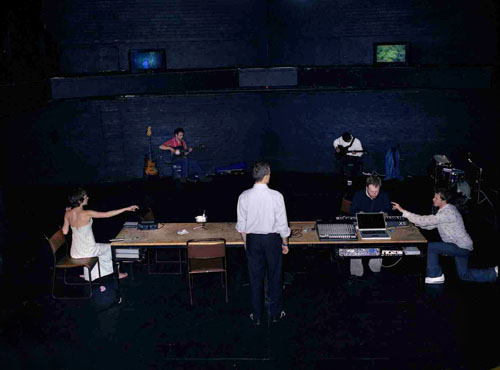
Maybe, then, this point, poised so between texture and text, the fuzzy and the clear, the background and the foreground, expresses a fundamental discontinuity, that is, between space-time (as we ordinarily experience it) and idea (that is, what it is possible to think) and mood (what we are actually feeling now in the room with these others). This discontinuity of the image echoes Barthes’ notion of punctum and runs counter to the commonsense understanding of an image as a representation that in some way represents something recognizably or allusively. Furthermore, for this discontinuity to work it can only ex-press itself by way of space and time: in other words, the image is never a fixed or still thing; for it to be recognized as an image (in the strict sense we are formulating), an image will always be in the work of rendering. This in-between-ness of the image concurs with Husserl’s notion of categorical perception, in which consciousness is achieved by means of an “objectifying act” that relates sensible perceptions to each other by means of a theorization. This produces what Husserl terms “aspects” – although I prefer the term – perspectives on / of reality, never a totality, so much so that “every perception is an ex-ception” (Levinas: 19) (literally – “a taking-through is a taking-from”). The image can only appear in this disjunctive relation of perspective to totality.
Not only is their [physical objects’] existence relative to a multiplicity of aspects in which they are intimated but, moreover, these aspects never exhaust things: by right, their number is infinite. (Levinas: 21)
For us, the force of the image lives in this capacity to express itself through space and time; and the recognizing of the image becomes the witnessing of its unfolding through a particular space-time, an event, a performance. This force is the de-second-naturing we crave in our work: the undoing of the strong bonds of comparability the word with the thing with the event, the jangling of the strong harmonies of synchronicity the ear with the eye with the room and our times, the wrecking of the strong principles of complicity our self with our world with our ideas. True discontinuity, the actually felt irruption of the image into the everyday – its ex-cept-ing, is not understood as an act of comparison – this is not like that; it is felt as both a mood of de-naturing and an instant when-where one’s Self is forced out of its self, interested in (in the sense of esse/being inter/between) the world.
Once the image has been rendered or captured through some sort of technology, it has already become in effect an after-image. And at this point, our interest in found imagery comes into play. The above logic of the eventness of any image may suggest that, once the event has passed, the image no longer retains the same force: and to some extent, this law of diminishing returns holds true. If everything eventually passes, then the force we still feel when we look at certain images, or rather, their remains as after-images (as we feel when we hear certain music), must be a less intense experience than when we first encountered the image, or rather, were part of the event of its materializing. This would only be the case if subsequent materializations were to happen in some kind of impossibly abstracted world in which no other forces were at play except one’s impossibly isolated self and the after-image. In fact, found images can retain or even exceed their “original” force by virtue of the subsequent investments made in them by others, and by the way those combined investments and materializations have inflected other events.

This is due to the problem posed by the image. And the working through of an image’s problem accounts for its sustainability, its durability in any particular culture. It accounts for the miraculous nature of sacred imagery and the transcendental quality of “great art”. This is occasioned at every event by encountering, in the case of performance – as a face-to-face, aspects of the everyday brought to the image by the auditor-spectators. All of these attributes are the problem posed being worked out by successive encounters with the after-images of an image’s original materialization. None of this accounts for why a certain image sustains over centuries, whilst others expressing similar problems disappear. Certainly for an image to endure it must be attended to, it must be constantly mastered, in the sense of re-rendered; and as such, is subject to the same forces Serres describes in all mastery – the judgement and skill required in getting on and riding a wave as it crashes to the shore.
The transcendent virtuoso passage on the violin or the piano is executed with precision by the master, whereas another player would get hung up on it. Of course no one has ever died from playing a wrong note; nonetheless the whole career of any virtuoso is decided at each instant in such passages. He is not playing an instrument, but always playing and betting his whole existence. (Serres 1995c: 112)
Some images get caught up and carried forth by bigger waves than others: for example, at this point in our culture, Sophocles deals with many of the same problems as did Shakespeare, and yet we are more likely to get a bigger thrill from playing and watching Hamlet than Oedipus. Some images burn brightly for a short time and then go out: the history of performance is full of examples of theatrical forms that are no longer practised. It seems to be that once an image has disappeared, the problem it poses can only be re-presented in a new image: it must wait for a new time and a new place. The various archetypical images in WHO BY FIRE all variously provoked strong responses in individual audience members, who each in their own way recognized the force of the problem posed by the image.
If we found ourselves stressing the local-temporal nature of the materializing of an image, as evidenced by performance as an art-practice, then one other feature of the point of realization came into focus for us, strengthened by our dwelling on the human life-cycle, and thence a generational surpassing: that is – every point is a turn: both a pre-position and an exit-trajectory.
The dancer, being inarticulate, precedes articles. Adept at all positions, he expresses pre-positions. … He indicates towards, to, on, by, in, out of, behind, before, close to, under, between, during, after, before, despite, against, except … All space, all time, all circumstances, relations and relationships. A universal mediator. Dance shows us a body, which is pre-posed, in the same way that music enables us to hear pre-posed meaning. (Serres 1995a: 127/9)
This point has both a coming and a going, a before and an after, a history and a future, an inheritance and a gift. The metaphor of the turn resonates both from classical grammar, the tropos being a forcing of a word’s meaning into another sense, linked to topos as the place of crossings of meanings or of features common to any set, and from astrophysics where a satellite uses the gravity of a planet to alter its course. This notion of forcing is in the specific sense of borrowing or stealing energy from another body, in the way that a person trained in the skills of martial arts can turn the weight of a larger opponent to their advantage, counter-intuitively, against commonsense, requiring an advantage of knowing. This echoes Bohm’s definitions of raw and subtle energy, the difference between (say) the heat of the sun and a radio signal: in-formation, the informing of matter to increase its complexity and responsiveness. So, the turning of the point is an inflecting, an informing of previously existing material, altering its trajectory, forcing a realignment or re-positioning. Furthermore, this forcing has the effect of revealing the presence of something indirectly, so that the turning of a point becomes the disclosing of a relation – a by-way-of.
In terms of human chronology in WHO BY FIRE, this produces a generational timeline, turning around the use of the voice, the acquisition of speech, the training of a singer, and the self-conscious awareness of one’s own competences, turning performers away from their disciplinary homes and forcing them into another place (topos), performers singing, musicians dancing, babies composing, old women remembering. Hence the three generations of women in the work and its exploration of transdisciplinarity within the collaborative mixing.
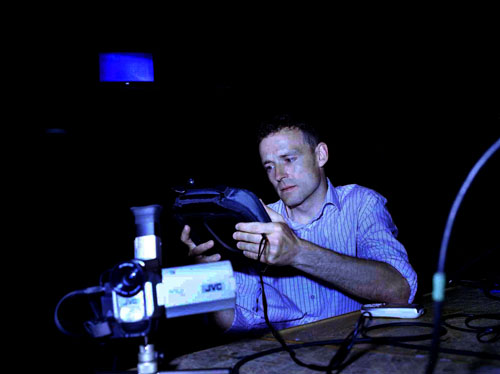
As a work of principling, we did not find how to realize the image itself in the performance-event. Despite the use of found pictures and tableaux vivants throughout the work, it never appeared, even as a freeze-frame. However, by way of working with this material, we found that it could only ever be disclosed as a trajectory inflected, and then only ever indirectly, that is, never seen as it appeared to be, only felt as a place when-where an image should have appeared. It was only felt in the pro-position of the image, in the perspective upon it, the pre-positionality of its in-forming; and then, after its appearance, in the impossible place it had pointed towards as a future destination. In this sense, we found that the force of the image could not itself be forced. Rather than be approached directly, it would relate itself to the energies bundling and gathering together within the event, as would subtle to raw energy (in Bohm’s terms), by way of unpredictable perspectives.
The preposition … simultaneously has the maximum and minimum of meaning, exactly like a variable in classical analysis. From – the French de – indicates origin, attribution, cause, and thus almost anything. (Serres 1995b: 106)
And these pre-positions and after-images, as fundamentally ex-posed in their relationalities, what Whitehead would have called their character, were never objective in the sense of purely exceeding the participants of each performance. They were apprehended variously from many different perspectives: effectively they were given meaning by those attending to their materializing, apprehending them as pre-tending images. This is why the principling of a work must remain an ever open, dynamic set of relations, non-teleological: the work will find itself, but only by way of and amongst its participants. And whilst each participant would not have openly expressed the particular quality of their own engagement with the image, their own inter-esse, each of these investments had the effect of variously in-forming the mood of the performance, indirectly disclosing (this little miracle-fragment of) the sacred, indirectly as a relation, as the point when-where an image should have appeared, a kind of divine could have been incarnated and then-there the word would have been made flesh.
[FOLLOW [link] then click on PLAYER]
by Bodies in Flight & Angel Tech
The party’s done. Six hangers-on share bizarre stories of accidental deaths, killing time before going home, on the eve of something big. Facing the void: like children facing the future, lovers facing each other, the old facing death.
TIM ATACK - sound
DOUG BOTT - sound
BEN CLOUGH - performer & video
POLLY FRAME - performer
SARA GIDDENS - choreography
NEIL JOHNSON - sound
SIMON JONES - direction & lyrics
TONY JUDGE - video
GRAEME ROSE - performer
and on video:
Mark Adams, Sheila Gilbert, Ella Judge, Sam Lambshead, Alisdair McKee, Tom Wainwright.
Photography by
EDWARD DIMSDALE
TRIPTYCH video installation by
SARA GIDDENS & TONY JUDGE
WHO BY FIRE was commissioned by Opera 2004 (BAC), funded by Arts Council of England, performed at BAC (London) & as part of Mayfest at The Bristol Old Vic, also at ICA (London), Wickham Theatre (Bristol), Powerhouse (Nottingham) as part of Sensitive Skin Festival, and Bretton Hall (University of Leeds) as part of PARIP International Conference (2005). TRIPTYCH was made as part of the Choreographic Lab (Northampton) (2006).
WEB-LINKS
www.bodiesinflight.com [link] www.angeltech.co.uk [link]
DOCUMENTATION of WHO BY FIRE (2004-05), as well as SKINWORKS (2002-04) and BODIES IN FLIGHT’s archival CD-ROM – FLESH & TEXT (2001), are available at www.bodiesinflight.com
